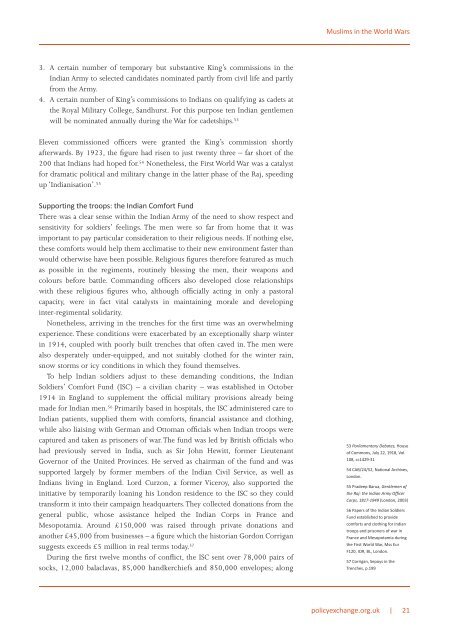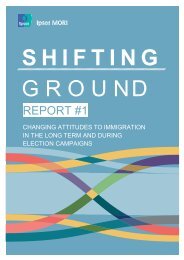You also want an ePaper? Increase the reach of your titles
YUMPU automatically turns print PDFs into web optimized ePapers that Google loves.
3. A certain number of temporary but substantive King’s commissions in the<br />
Indian Army to selected candidates nominated partly from civil life and partly<br />
from the Army.<br />
4. A certain number of King’s commissions to Indians on qualifying as cadets at<br />
the Royal Military College, Sandhurst. For this purpose ten Indian gentlemen<br />
will be nominated annually during the War for cadetships. 53<br />
Eleven commissioned officers were granted the King’s commission shortly<br />
afterwards. By 1923, the figure had risen to just twenty three – far short of the<br />
200 <strong>that</strong> Indians had hoped for. 54 Nonetheless, the First World War was a catalyst<br />
for dramatic political and military change in the latter phase of the Raj, speeding<br />
up ‘Indianisation’. 55<br />
Supporting the troops: the Indian Comfort Fund<br />
There was a clear sense within the Indian Army of the need to show respect and<br />
sensitivity for soldiers’ feelings. The men were so far from home <strong>that</strong> it was<br />
important to pay particular consideration to their religious needs. If nothing else,<br />
these comforts would help them acclimatise to their new environment faster than<br />
would otherwise have been possible. Religious figures therefore featured as much<br />
as possible in the regiments, routinely blessing the men, their weapons and<br />
colours before battle. Commanding officers also developed close relationships<br />
with these religious figures who, although officially acting in only a pastoral<br />
capacity, were in fact vital catalysts in maintaining morale and developing<br />
inter-regimental solidarity.<br />
Nonetheless, arriving in the trenches for the first time was an overwhelming<br />
experience. These conditions were exacerbated by an exceptionally sharp winter<br />
in 1914, coupled with poorly built trenches <strong>that</strong> often caved in. The men were<br />
also desperately under-equipped, and not suitably clothed for the winter rain,<br />
snow storms or icy conditions in which they found themselves.<br />
To help Indian soldiers adjust to these demanding conditions, the Indian<br />
Soldiers’ Comfort Fund (ISC) – a civilian charity – was established in October<br />
1914 in England to supplement the official military provisions already being<br />
made for Indian men. 56 Primarily based in hospitals, the ISC administered care to<br />
Indian patients, supplied them with comforts, financial assistance and clothing,<br />
while also liaising with German and Ottoman officials when Indian troops were<br />
captured and taken as prisoners of war. The fund was led by British officials who<br />
had previously served in India, such as Sir John Hewitt, former Lieutenant<br />
Governor of the United Provinces. He served as chairman of the fund and was<br />
supported largely by former members of the Indian Civil Service, as well as<br />
Indians living in England. Lord Curzon, a former Viceroy, also supported the<br />
initiative by temporarily loaning his London residence to the ISC so they could<br />
transform it into their campaign headquarters. They collected donations from the<br />
general public, whose assistance helped the Indian Corps in France and<br />
Mesopotamia. Around £150,000 was raised through private donations and<br />
another £45,000 from businesses – a figure which the historian Gordon Corrigan<br />
suggests exceeds £5 million in real terms today. 57<br />
During the first twelve months of conflict, the ISC sent over 78,000 pairs of<br />
socks, 12,000 balaclavas, 85,000 handkerchiefs and 850,000 envelopes; along<br />
Muslims in the World Wars<br />
53 Parliamentary Debates, House<br />
of Commons, July 22, 1918, Vol.<br />
108, cc1429-31<br />
54 CAB/24/52, National Archives,<br />
London.<br />
55 Pradeep Barua, Gentlemen of<br />
the Raj: the Indian Army Officer<br />
Corps, 1817-1949 (London, 2003)<br />
56 Papers of the Indian Soldiers<br />
Fund established to provide<br />
comforts and clothing for Indian<br />
troops and prisoners of war in<br />
France and Mesopotamia during<br />
the First World War, Mss Eur<br />
F120, IOR, BL, London.<br />
57 Corrigan, Sepoys in the<br />
Trenches, p.199<br />
policyexchange.org.uk | 21



